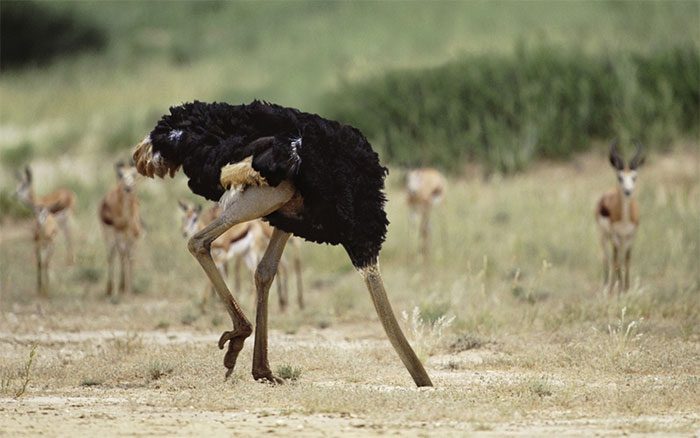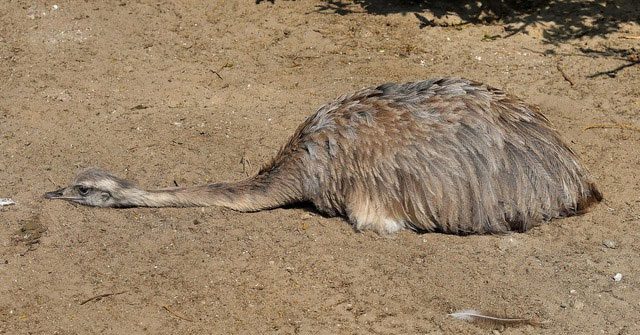The idea that ostriches bury their heads in the sand when they feel threatened is believed to have originated from the Roman naturalist Pliny the Elder around 2,000 years ago. But is this actually true?
For centuries, it has been thought that when faced with danger, ostriches bury their heads in the sand to hide. This vivid image has led to the popular phrase “bury your head in the sand”, implying avoidance of a problem rather than confronting it.

When faced with danger, do ostriches really bury their heads in the sand to hide?
According to some sources, the Roman naturalist Pliny the Elder, also known as Gaius Plinius Secundus, may have been the first to popularize the belief that ostriches hide their heads when in danger. In his famous work “The Natural History” – one of the earliest encyclopedias about the natural world, Pliny described the ostrich as a giant creature with a foolish behavior, believing that by hiding its head, it could conceal its entire body. He wrote: “They have the remarkable characteristic of being able to digest everything indiscriminately, but their stupidity is equally remarkable; for although the rest of their body is very large, they think that by pushing their head and neck into a bush, their whole body will be concealed.”
Pliny’s description of the ostrich inadvertently formed a fixed image in the minds of many generations, leading people to believe that this giant bird would indeed “bury its head in the sand” to avoid predators. However, this belief is completely mistaken.

In reality, ostriches never bury their heads in the sand to escape danger.
In fact, ostriches never bury their heads in the sand to avoid danger. They are very agile birds, capable of reaching speeds up to 70 km/h (43 mph) – recognized as the fastest running bird in the world, according to the Smithsonian National Zoo. Ostriches do not need to bury their heads in the sand because they can effectively escape danger due to their superior speed and sharp instincts against threats from natural predators such as leopards, lions, and hyenas.
One behavior that may have led to this misunderstanding is how ostriches care for their eggs. Unlike many other birds, ostriches do not build nests in trees but dig shallow holes in sand or soil to lay their eggs. Both male and female ostriches rotate the eggs several times a day to maintain a stable temperature. From a distance, this action may lead us to mistakenly believe that ostriches are “burying their heads in the sand.”
Additionally, ostriches often lower their heads to search for food. They eat various plants, grass seeds, and even small animals like mice, frogs, and insects. When lowering their heads close to the ground while foraging, ostriches may appear to be burying their heads in the sand, easily leading to misinterpretation.

If they cannot escape danger, they will lie very low, pressing their bodies to the ground.
If ostriches cannot escape danger, they may employ another defensive tactic. They will lie very low, pressing their bodies to the ground, extending their necks to blend into the terrain. This helps them resemble a rock or bush, allowing them to avoid the attention of predators. Additionally, according to some studies, adult ostriches also use their wings to stir up dust to distract enemies and protect their chicks.
Surprisingly, ostriches also possess powerful self-defense capabilities, with kicks that can be lethal. It is reported that a kick from an ostrich can be strong enough to kill a lion – a powerful predator of Africa.


















































